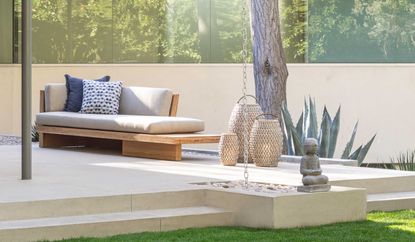What is a rain chain? How to use this downpipe replacement for a more stylish, calming backyard
The traditional Japanese rain chain is a great alternative to your traditional drain pipes. Architects tell us how they work and when to use them


Water drainage from your roof is hardly going to be the most exciting part of your remodel, but when you find yourself staring at a plastic downpipe in your otherwise beautifully appointed backyard, you may wish you'd spent a little longer considering the details. Although, you can't deny how out of place your existing drainpipes look in the garden.
Of course, they serve a purpose when it rains, but the effects of an unsightly drainpipe extends to all seasons, ruining alfresco dining settings and ambient fire pits. If you are looking to upgrade your rainwater solution, then have you considered a rain chain?
What is that I hear you ask? These ornamental backyard features may look decorative, but although they do provide a visually interesting element to an otherwise mundane feature of your outdoor space, they serve a vital function. Similar to your traditional gutter, it channels water from your roof guttering into a grated pit or water butt.
The rain chain is traditionally a common feature in Japanese architecture. They often use them in temples as a building characteristic to promote an emotional response to the four seasons. Watching the water cascade down the chain is a meditative practice to observe and embrace nature. ‘Traditionally, they have been common in parts of Asia where rainfall is high but are expressed as a meditative way to observe and embrace nature,' explains says architect Sonia Sarangi. 'It definitely serves an aesthetic purpose too, but in these crazy times it's a good reminder to just pause and watch everyday natural phenomena too.'
We could all use a bit more zen in our lives, and converting your drainage systems to a rain chain might be the most inspired way to get it.
How does it work?

It's simple physics that makes the whole system work. 'It works by simply giving the water a series of drip points,' Matthew Wood, architect and founder of MW Architects, who included one in his own home design, explains. 'It drips between each lock on the chain.'
'Instead of a traditional full-length downpipe, there is a small connector section that mimics a traditional downpipe so water can drain effectively from the gutter,' Sonia adds. 'The rain chain is then suspended and attached in the cross-section void of the connector via a rod. The water then simply flows down the chain links.'
A rain chain can act like a normal gutter system, by funnelling water into a grated pit. However, if you are an avid gardener keen to make your practices more sustainable, the pit can be connected to a rainwater tank to harvest for your garden. They can also be placed above a water butt or water feature to allow the rain to drip directly in, while contributing to a wonderful sensory garden.

Why should I get one?
There are obvious design advantages to getting a rain chain. Sonia worked closely on Cascade House where she utilized a rain chain as a design feature. Sonia wanted to incorporate nature into the design in a unique way to reflect the client's love for the nearby creek. '‘They wanted to reflect that element of water somehow but not in the usual "water feature-pond" way,' she tells us. 'So it made sense to take something prosaic like roof drainage and elevate it instead.'
Equally, Matthew also used a rain chain to add a bit of intrigue. ‘The copper chain is a beautiful thing in itself,’ he says, ‘starting off bright and golden it ultimately patinas to that beautiful green so unique to this natural material. The prospect of that happening over a long period of time excites me.’
The chain ultimately performs a pretty boring function, but it can be harnessed to add to the overall aesthetic of your home. In Matthew’s home, it is placed in the center of an otherwise blank brick wall, the positioning gives an element of visual intention to focus on. 'The chain provides a little bit of interest of what otherwise would be a bit of a backside view,’ he explains.
It's also less prominent than a downpipe. 'A chain is transparent and light visually,' explains Matthew. 'And they don't even need to touch the ground. The purpose is simply to guide the water down such that wind does not blow it back to the building, if the distance is enough and the chain gets close to the ground (or sometimes a pool of water) the building is protected.'
Are there any drawbacks?
The practicality of this system should be considered if you live in a particularly windy place. Sonia explains how this can affect the system, ‘when there is a windy day the water flow can be interrupted’ causing some excess splash.
For this reason, rain chains are not suitable for all homes, particularly if they are located close to the wall. However this is also dependent on your building material type, Mathew has a rain chain tightly connected to his wall. ‘This is only really possible because we used engineering bricks. Plain and utilitarian but pretty waterproof compared to London stock bricks,’ he explains.
'One thing further to add is that they work better with slower rain,' add Matthew. 'So my roof actually has a sedum matt on it and that works like a buffer so the water comes off the roof slower than it would without but takes longer to drain.' This means the dripping goes on long after the rain stops, which means you can enjoy the sensory nature, even when it's not raining outside.
Should I get a rain chain?

As previously mentioned, a rain chain is not suitable for all homes. They can splash and if placed close to the building where waterproof materials have not been used this could cause problems like damp.
However, if you have large overhanging eaves they hold fantastic practical advantages. In these circumstances a large structural drain would break up the silhouette of the building.
Sonia advises opting for a rain chain in this case. 'It has an elegance when it is not raining as opposed to a solid pipe that would appear to be a structural column,’ she says ‘There are other practical advantages for buildings with large overhanging eaves because they move in the wind and snow and during earthquakes. A ridged pipe doesn’t like that.’ The practicality should be considered for your home before choosing this form of drainage.
Rain chains are the perfect mix between practical and ornamental, and provide a visually appealing alternative to your traditional plastic black drain pipe. Consider this understated update for your next home improvement for a simple design that contributes to your garden vision rather than obstructs it.
3 of the best rain chains
 Best copper chain
Best copper chain
 Best modern chain
Best modern chain
 Best statement chain
Best statement chain
Be The First To Know
The Livingetc newsletter is your shortcut to the now and the next in home design. Subscribe today to receive a stunning free 200-page book of the best homes from around the world.

Amy recently completed an MA in Magazine Journalism at City, University of London, with experience writing for Women’s lifestyle publications across arts, culture, and beauty. She has a particular love for the minimalist aesthetic mixed with mid-century furniture, especially combining unique vintage finds with more modern pieces. Her previous work in luxury jewellery has given her a keen eye for beautiful things and clever design, that plays into her love of interiors. As a result, Amy will often be heard justifying homeware purchases as 'an investment', wise words to live by.
-
 The 12 Best Table Lamps for Reading —I'm a Certified Bookworm (and Shopping Expert)
The 12 Best Table Lamps for Reading —I'm a Certified Bookworm (and Shopping Expert)When it comes to table lamps for reading, I don't mess around. If you're the same, this edit is for YOU (and your books, or course — and good recommendations?)
By Brigid Kennedy Published
-
 "It's Scandi Meets Californian-Cool" — The New Anthro Collab With Katie Hodges Hits Just the Right Style Note
"It's Scandi Meets Californian-Cool" — The New Anthro Collab With Katie Hodges Hits Just the Right Style NoteThe LA-based interior designer merges coastal cool with Scandinavian simplicity for a delightfully lived-in collection of elevated home furnishings
By Julia Demer Published

